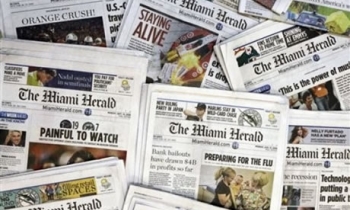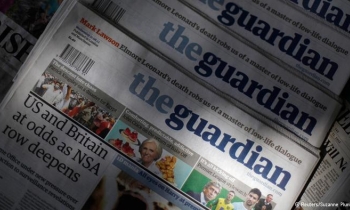The biggest news industry story of 2008 in the US, expectedly, is about job cuts, says leading industry magzine Editor & Publisher. The US Department of Labour estimates that around 21,000 newspaper industry jobs disappeared this year.
E&P's 'Top Ten Newspaper Industry Stories of the Year', listed by Senior Editor Joe Strupp are as follows: [Link]
- Record Job Cuts: Three years ago, this was the top industry story of the year when some 2,000 newspaper jobs were lost in 2005. This year, Gannett cut that many in December alone, after slashing 1,000 others in August. Then there is McClatchy with two rounds of cuts, totaling 2,500 jobs; Tribune slashing more than 1,000; and various other small dailies and chains dropping staff here and there. The Star-Ledger of Newark, N.J. saw more than 300 buyouts, while more than 100 jobs were lost each at The Washington Post, Atlanta Journal Constitution, Newsday and others.
- As the (Web) World Turns: Several daily newspapers dropped their daily print distribution for Web, including the Christian Science Monitor, while the Detroit News and Detroit Free Press stopped home delivery four days a week, with a push toward daily Web expansion. Several others, from The Plain Dealer in Cleveland to the Sun-Sentinel of Fort Lauderdale, Fla., also cut back pages, while The New York Times combined several sections. Ironically, all of this occurred as newspaper online revenue stopped its slow and steady growth and began to fall for the first time.
- Stocks Crash: Newspaper share prices collapsed, ranging from a best of about 60% decline in value to more than 90%. Not to mention the delisting from the New York Stock Exchange of three publicly traded companies: Sun-Times Media Group, Journal Register Co., and GateHouse Media. Of course, few on Wall Street were celebrating this year in any industry, but for newspapers, another body blow in a tough economic year.
- Tribune Co: A year ago, Sam Zell was a question mark as the new owner of the media company with no newspaper experience. In the past 12 months, the question has been answered with the company filing for bankruptcy, redesigning its newspapers in some bizarre ways, and slashing staff and combining coverage in its Washington bureau. Even the company's Chicago Cubs are having trouble finding a buyer. Zell strikes out in this ballpark.
- Associated Press Faces Challenges: It started with some complaints from two groups of editors about a year ago, claiming a new AP rate structure for 2009 did not cut costs enough. Many also lamented what they saw as poor regional coverage and other AP deficiencies. Cancellation notices began with the likes of The Star Tribune in Minneapolis and The Columbus (Ohio) Dispatch giving the required two-years warning. Tribune Co. even gave notice for all of its dailies, which include the Los Angeles Times and Chicago Tribune. AP countered with further rate cuts and a reorganized D.C. assignment that emphasizes regional coverage, but the dispute seems far from over. Will the papers really go through with the cutback?
- Election Day (After): The ongoing circulation slide took a holiday on Nov. 5, the day after Barack Obama won the presidential election. Despite massive broadcast, cable and Web coverage of the first black president-elect, hundreds of thousands of people went to their print newspaper to grab a piece of history. Lines formed around the block at several newspapers as USA Today printed 500,000 extra copies, the Chicago Tribune another 200,000, and the New York Times and Atlanta Journal Constitution more than 100,000 each. The Washington Post even put out a 26-page extra edition. Ebay still had more than 800 ads for such papers this week, with one 20-copy package of the Times priced at $199.
- Lost Editors: Five of the nation's largest newspapers changed or announced pending changes of top editors. Along with the Post and Journal, noted above, the Los Angeles Times, Chicago Tribune, and USA Today made such moves. Other notable papers with new newsroom leadership included the San Francisco Chronicle, Arizona Republic, San Jose Mercury News, and Austin American-Statesman, among others.
- New Leaders at The Washington Post: The legendary paper saw some of its biggest changes ever in 2008, with 17-year Executive Editor Leonard Downie Jr. retiring and replaced by Wall Street Journal managing editor Marcus Brauchli; a newsroom-record six Pulitzer Prizes; and the buyout of more than 100 staffers. The daily also got a new publisher, Katharine Weymouth, and announced preliminary plans to converge its Web and print newsrooms.
- Newspaper Guild Gets New Prez: After 12 years at the helm, Newspaper Guild President Linda Foley lost a bitter campaign to longtime vice-president Bernie Lunzer. The election included dueling videos and Web sites with attacks back and forth. When the dust settled, Lunzer won, but faces a $200,000 deficit and dwindling membership as the industry continues to cut jobs. Even the union's monthly newspaper cut back to bi-monthly publication.
- Pulitzer Open to Web-only: Think what you want about the Pulitzer Prizes being somewhat old-fashioned and tied to tradition. But the 91-year-old awards, which have slowly welcomed the Web into their world, made a major leap in 2008, announcing that non-newspaper Web sites will be eligible for the coveted prizes. While those tied to magazines and broadcast and cable are still barred, news Web sites unrelated to newspapers that produce original content can submit. So could we see The Washington Post and Minnpost.com share a prize? Stay tuned.










